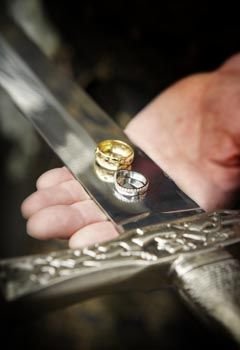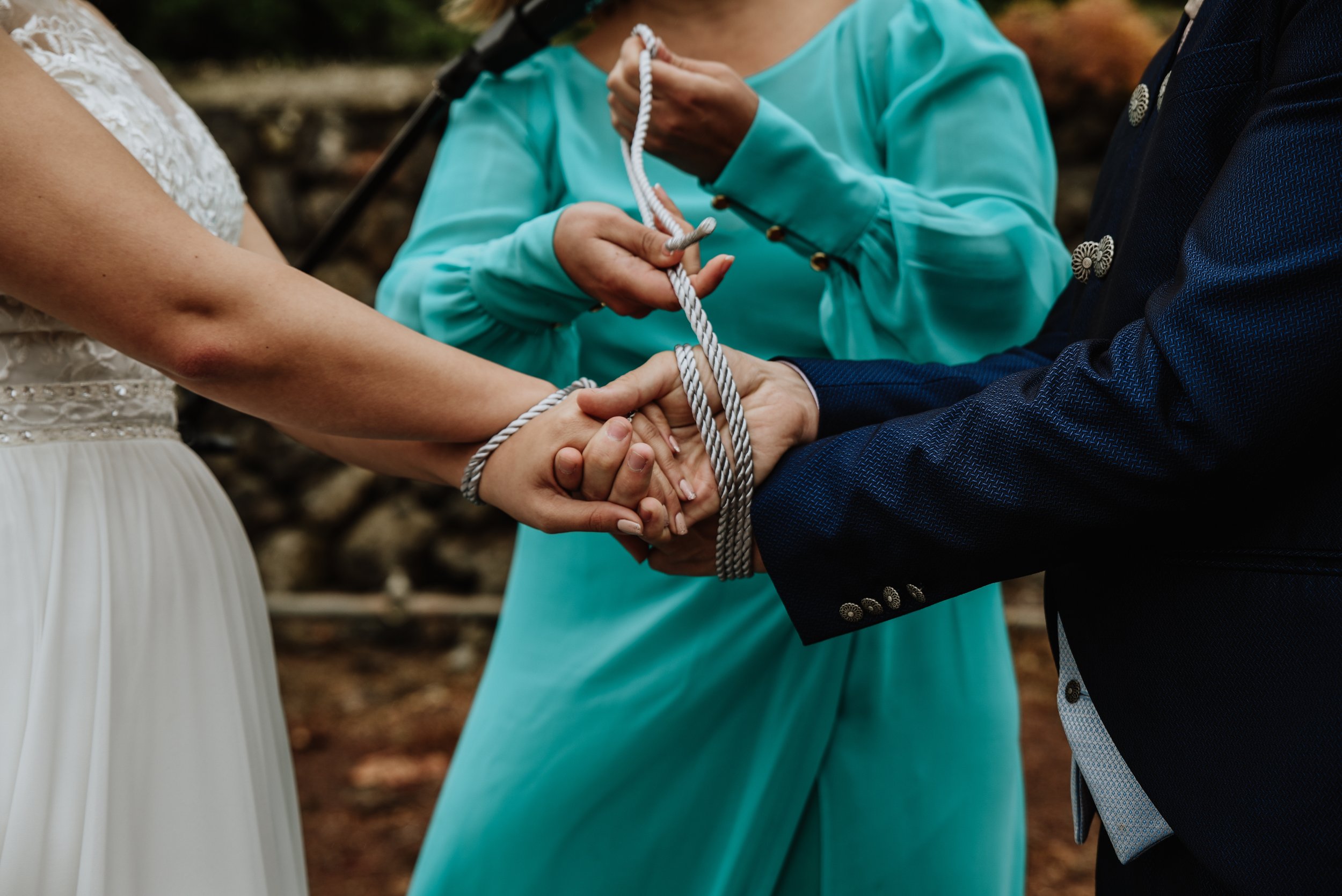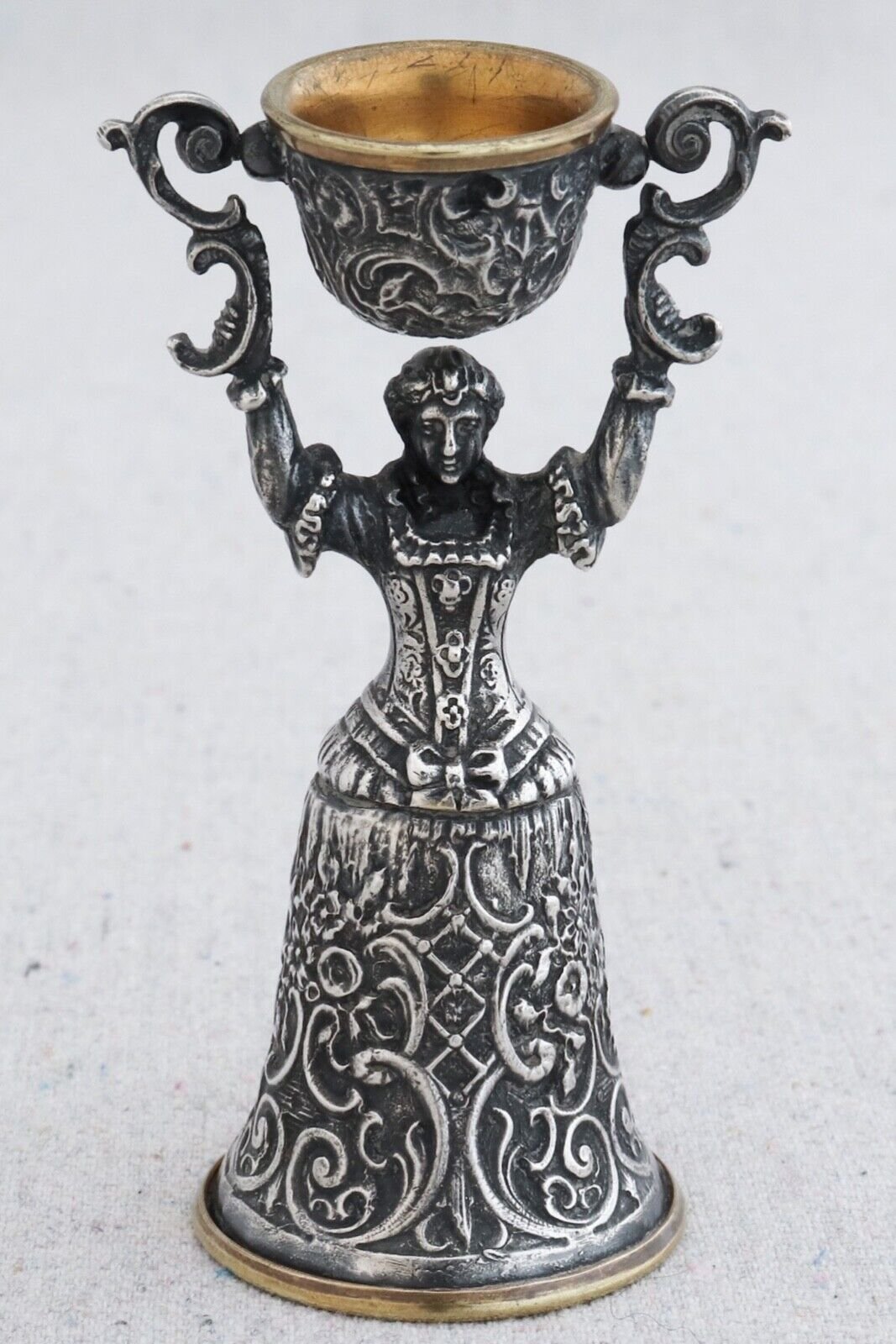Traditions You’ll See at Our Wedding
Sword Ceremony
Using swords as part of a wedding ceremony is an ancient custom. The Roman historian Tacitus claimed that a German/Nordic husband and wife exchanged gifts of weapons when they were wed.
The ceremony you’ll see draws on the ancient tradition of swearing fealty to a lord or lady. This was done by presenting one’s sword to the other party. It was popularized during the chivalric period (11th-12th century) and is often seen in art, movies and television as a knight swearing fealty to his queen or lady. (Think Guinevere and Lancelot.)
You’ll also see the wedding ring presented on the flat of a sword for blessing and for the bride and groom to exchange. This comes from Nordic tradition.
Both swords you’ll see used in the ceremony are from Chris’ grandparents. The one he will present to Niki is his grandfather’s military sword and is his most prized possession. Chris recieved it when he was about four or five years old and it has been very influential on his life and the things he has chosen to study.
In one variation, the groom draws his sword, kneels down on one knee, places the ring on the hilt of the sword and holds it out to the bride as an offering. The bride accepts the ring, places it on her own finger, and ‘knights’ her partner with his sword. This ritual symbolizes the groom’s promise of loyalty and protection, and the bride’s autonomy and willingness to marry.
Handfasting
Handfasting is an ancient practice of commitment practiced by both Niki’s Celtic ancestors and Chris’ Nordic ancestors. Historically, it dates back to about 7000 BCE was originally more like an engagement, often only lasting a year and a day., after which the couple would marry or go their separate ways. Fun fact: handfasting is the origin of the phrase “tying the knot.” Historians believe that handfasting was also used at the beginning of the 18th century to mark the beginning of a “trial marriage” of a year and a day for a young couple. The popularity of handfasting has grown in recent years as neopagans and others have begun incorporating it into their wedding services. Anyone of any faith (or none at all) may practice handfasting.
The handfasting ceremony is simple: the couple’s hands are bound together by a cord by the officiant and after they exchange vows, the cord is slipped off without untying the knot. Many couples choose to display their cord in their home as a reminder of their commitment to one another. During a marriage ceremony, this ritual serves much the same purpose as a unity candle or sand ceremony; it symbolizes the two people becoming one, or in this case, literally being bound to one another. The cord itself is also a tangible symbol of the binding nature of the vows the bride and groom make to one another.
Unity Candle
Unity candles are common in Christian wedding ceremonies. In most traditions, the bride and groom each light one of the smaller candles and together light the central candle. Like the handfasting, the lighting of a unity candle represents the joining of two lives into one.
The central candle Niki and Chris are using is one Niki decorated when she was working with life coach Sandy Tomey (who will hopefully be at the wedding). It is paper mached with phrases and photos of things Niki was hoping to manifest in her future partner. Chris meets every single one of them.
Memorial Table
We have both lost loved ones who we wish could be present at the wedding. We will leave empty seats for Chris’ mother, Maryrose Hart, and Niki’s grandmother, Elisabeth Lawson. Other relatives who have passed away will be honored by having a photo on a special memorial table.
Niki and Chris will honor them by leaving flowers on the table and saying a brief prayer at the end of the ceremony.
German Wedding Cup/Norse Horn
At the reception you’ll see us drink from a German wedding cup and a Norse drinking horn. In Norse tradition, the bride presented her groom with a drinking horn as a sign of providing for hearth and home. Niki will drink after Chris to make the tradition a little more modern.
The German wedding cup or bridal cup dates from about 1450 in Nuremberg, Germany. Legend says a wealthy nobleman disapproved of his daughter's choice of a husband, a goldsmith. The father had the goldsmith sent to a dungeon, but the girl became ill, and her father finally agreed to a test for her beloved. If the goldsmith could make a chalice that two people could drink from at the same time without spilling a drop, the pair could wed. The goldsmith made the swiveling cup, and they were permitted to marry.
In keeping with this tradition, the newly married couple must drink from the cup at the same time to assure a happy marriage. The lady-shaped cup is turned upside-down and the husband drinks from the skirt, the wife from the small cup that has now swiveled to be right side up. It is used for both a toast to and a trial of the newlyweds and is a symbol of love, faithfulness, and good luck and is used during the wedding toast.





